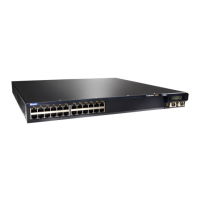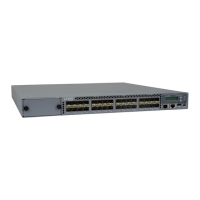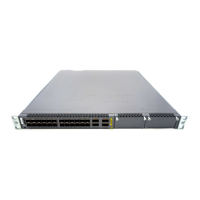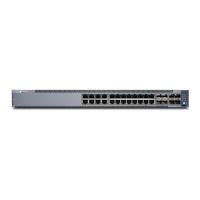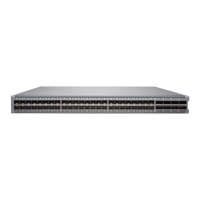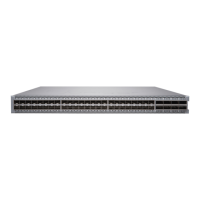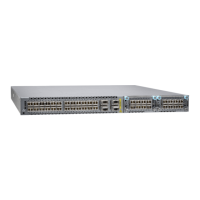8
Layer 2 Switching (continued)
• Physical port redundancy: Redundant trunk group (RTG)
• Compatible with PVST+
• RVI (Routed VLAN Interface)
• IEEE 802.1AB: Link Layer Discovery Protocol (LLDP)
• LLDP-MED with VoIP integration
• IEEE 802.1D: Spanning Tree Protocol
• IEEE 802.1p: CoS prioritization
• IEEE 802.1Q: VLAN tagging
• IEEE 802.1s: Multiple instances of Spanning Tree Protocol (MSTP)
• Number of MST instances supported: 64
• Number of VSTP instances supported: 253
• IEEE 802.1w: Rapid reconfiguration of Spanning Tree Protocol
• IEEE 802.1X: Port Access Control
• IEEE 802.1ak: Multiple Registration Protocol
• IEEE 802.3: 10BASE-T
• IEEE 802.3u: 100BASE-T
• IEEE 802.3ab: 1000BASE-T
• IEEE 802.3z: 1000BASE-X
• IEEE 802.3ae: 10 Gigabit Ethernet
• IEEE 802.3af: Power over Ethernet
• IEEE 802.3x: Pause Frames/Flow Control
• IEEE 802.3ad: Link Aggregation Control Protocol
• IEEE 802.3ah: Ethernet in the First Mile
• Metro
- PVLAN support
- IEEE 802.1ag connectivity fault management
- ITU-T G803.2
- ITU-T Y.1731
- IEEE 802.1ad Q-in-Q
- Multicast VLAN routing
Layer 3 Features: IPv4
• Max number of ARP entries: 16,000
• Max number of IPv4 unicast routes in hardware: 16,000
• Max number of IPv4 multicast routes in hardware: 8,000
• Routing protocols: RIPv1/v2, OSPF, BGP, IS-IS
• Static routing
• Routing policy
• Bidirectional Forwarding Detection
• Layer 3 redundancy: VRRP
• IPv4/v6 GRE tunneling
Layer 3 Features: IPv6
• Max number of Neighbor Discovery (ND) entries: 16,000
(shared with IPv4)
• Max number of IPv6 unicast routes in hardware: 4,000
• Max number of IPv6 multicast routes in hardware: 2,000
• Routing protocols: RIPng, OSPFv3, IPv6, ISIS, BGP4+, PIM, MLD,
MLDv2
• Static routing
MPLS
• Circuit Cross Connect (CCC)
• Multicast snooping MLD v1/v2
• VRF-Lite
Supported RFCs
• RFC 768 UDP
• RFC 783 TFTP
• RFC 791 IP
• RFC 792 ICMP
• RFC 793 TCP
• RFC 826 ARP
• RFC 854 Telnet client and server
• RFC 894 IP over Ethernet
• RFC 903 RARP
• RFC 906 TFTP Bootstrap
• RFC 951, 1542 BootP
• RFC 1027 Proxy ARP
• RFC 1058 RIP v1
• RFC 1112 IGMP v1
• RFC 1122 Host Requirements
• RFC 1195 Use of OSI IS-IS for Routing in TCP/IP and Dual
Environments (TCP/IP transport only)
• RFC 1256 IPv4 ICMP Router Discovery (IRDP)
• RFC 1492 TACACS+
• RFC 1519 CIDR
• RFC 1587 OSPF NSSA Option
• RFC 1591 DNS
• RFC 1745 BGP4/IDRP for IP-OSPF Interaction
• RFC 1771 Border Gateway Protocol 4
• RFC 1812 Requirements for IP Version 4 Routers
• RFC 1965 Autonomous System Confederations for BGP
• RFC 1981 Path MTU Discovery for IPv6
• RFC 1997 BGP Communities Attribute
• RFC 2030 SNTP, Simple Network Time Protocol
• RFC 2068 HTTP server
• RFC 2080 RIPng for IPv6
• RFC 2131 BOOTP/DHCP relay agent and DHCP server
• RFC 2138 RADIUS Authentication
• RFC 2139 RADIUS Accounting
• RFC 2154 OSPF w/Digital Signatures (Password, MD-5)
• RFC 2236 IGMP v2
• RFC 2267 Network Ingress Filtering
• RFC 2283 Multiprotocol Extensions for BGP-4
• RFC 2328 OSPF v2 (Edge-mode)
• RFC 2338 VRRP
• RFC 2362 PIM-SM (Edge-mode)
• RFC 2370 OSPF Opaque LSA Option
• RFC 2385 TCP MD5 Authentication for BGPv4
• RFC 2439 BGP Route Flap Damping
• RFC 2453 RIP v2
• RFC 2460 Internet Protocol, Version 6 (IPv6) Specification
• RFC 2461 Neighbor Discovery for IP Version 6 (IPv6)
• RFC 2463 Internet Control Message Protocol (ICMPv6) for the
Internet Protocol Version 6 (IPv6) Specification
• RFC 2464 Transmission of IPv6 Packets over Ethernet Networks
• RFC 2474 DiServ Precedence, including 8 queues/port
• RFC 2475 DiServ Core and Edge Router Functions
• RFC 2526 Reserved IPv6 Subnet Anycast Addresses
• RFC 2545 Use of BGP-4 Multiprotocol Extensions for IPv6 Inter-
Domain Routing
EX4200 Specifications (continued)
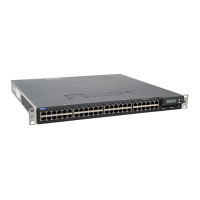
